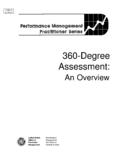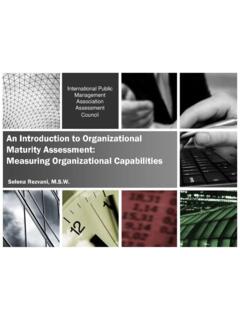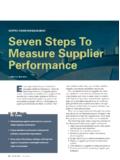Transcription of Organizational Culture Assessment Instrument
1 Results through People 2012 Organizational Culture Assessment Instrument Instructions for completing the Organizational Culture Assessment Instrument (OCAI). The purpose of the OCAI is to assess six key dimensions of Organizational Culture . In completing the Instrument , you will be providing a picture of how your organization operates and the values that characterize it. No right or wrong answers exist for these questions, just as there is no right or wrong Culture . Every organization will most likely produce a different set of responses. Therefore, be as accurate as you can in responding to the questions so that your resulting cultural diagnosis will be as precise as possible.
2 You are asked to rate your organization in the questions. To determine which organization to rate, you will want to consider the organization that is managed by your boss, the strategic business unit to which you belong, or the Organizational unit in which you are a member that has clearly identifiable boundaries. Because the Instrument is most helpful for determining ways to change the Culture , you ll want to focus on the cultural unit that is the target for change. Therefore, as you answer the questions, keep in mind the organization that can be affected by the change strategy you develop. The OCAI consists of six questions.
3 Each question has four alternatives. Divide 100 points among these four alternatives depending on the extent to which each alternative is similar to your own organization. Give a higher number of points to the alternative that is most similar to your organization. For example, in question one, if you think alternative A is very similar to your organization, alternative B and C are somewhat similar, and alternative D is hardly similar at all, you might give 55 points to A, 20 points to B and C, and five points to D. Just be sure your total equals 100 points for each question. Note, that the first pass through the six questions is labeled Now.
4 This refers to the Culture , as it exists today. After you complete the Now , you will find the questions repeated under a heading of Preferred . Your answers to these questions should be based on how you would like the organization to look five years from now. Results through People 2012 The Organizational Culture Assessment Instrument 1. Dominant Characteristics Now Preferred A The organization is a very personal place. It is like an extended family. People seem to share a lot of themselves. B The organization is a very dynamic entrepreneurial place. People are willing to stick their necks out and take risks.
5 C The organization is very results oriented. A major concern is with getting the job done. People are very competitive and achievement oriented. D The organization is a very controlled and structured place. Formal procedures generally govern what people do. Total 2.
6 Organizational Leadership Now Preferred A The leadership in the organization is generally considered to exemplify mentoring, facilitating, or nurturing. B The leadership in the organization is generally considered to exemplify entrepreneurship, innovating, or risk taking. C The leadership in the organization is generally considered to exemplify a no-nonsense, aggressive, results-oriented focus. D The leadership in the organization is generally considered to exemplify coordinating, organizing, or smooth-running efficiency. Total 3.
7 Management of Employees Now Preferred A The management style in the organization is characterized by teamwork, consensus, and participation. B The management style in the organization is characterized by individual risk-taking, innovation, freedom, and uniqueness. C The management style in the organization is characterized by hard-driving competitiveness, high demands, and achievement. D The management style in the organization is characterized by security of employment, conformity, predictability, and stability in relationships. Total Results through People 2012 4.
8 Organization Glue Now Preferred A The glue that holds the organization together is loyalty and mutual trust. Commitment to this organization runs high. B The glue that holds the organization together is commitment to innovation and development. There is an emphasis on being on the cutting edge. C The glue that holds the organization together is the emphasis on achievement and goal accomplishment. Aggressiveness and winning are common themes. D The glue that holds the organization together is formal rules and policies. Maintaining a smooth-running organization is important. Total 5.
9 Strategic Emphases Now Preferred A The organization emphasizes human development. High trust, openness, and participation persist. B The organization emphasizes acquiring new resources and creating new challenges. Trying new things and prospecting for opportunities are valued. C The organization emphasizes competitive actions and achievement. Hitting stretch targets and winning in the marketplace are dominant. D The organization emphasizes permanence and stability. Efficiency, control and smooth operations are important. Total 6.
10 Criteria of Success Now Preferred A The organization defines success on the basis of the development of human resources, teamwork, employee commitment, and concern for people. B The organization defines success on the basis of having the most unique or newest products. It is a product leader and innovator. C The organization defines success on the basis of winning in the marketplace and outpacing the competition. Competitive market leadership is key. D The organization defines success on the basis of efficiency. Dependable delivery, smooth scheduling and low-cost production are critical.










